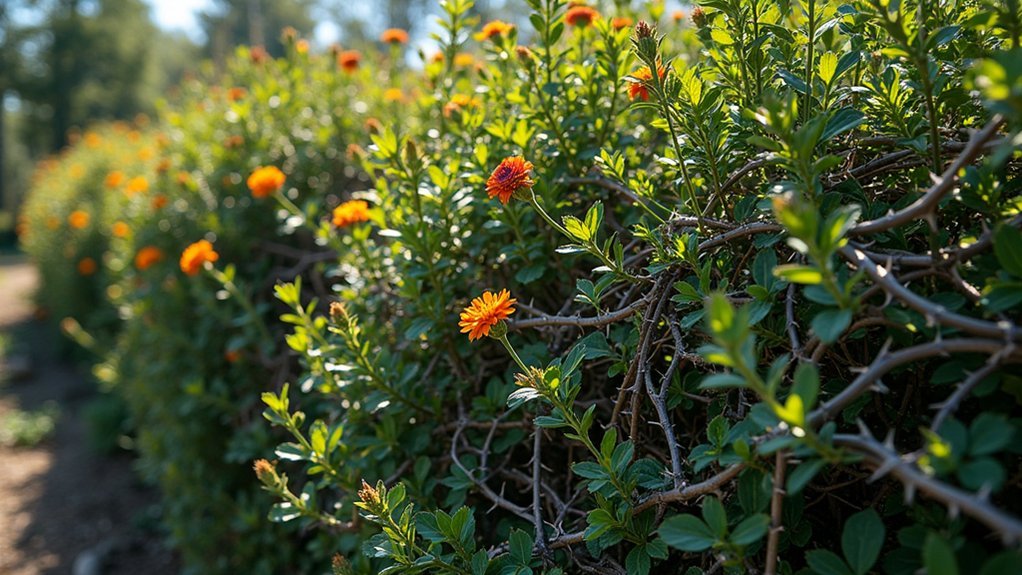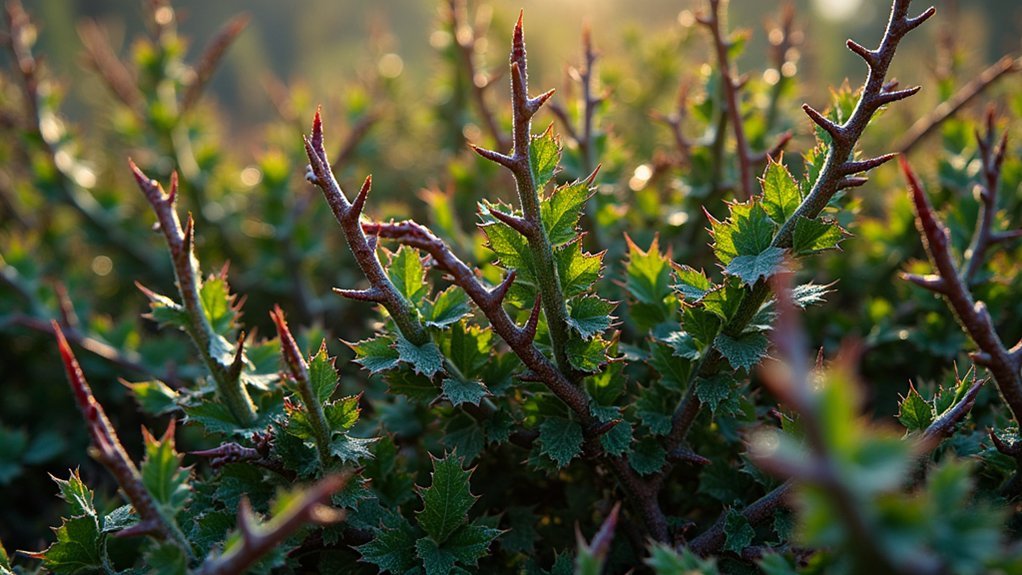Thorny shrubs create effective natural security barriers while enhancing your landscape’s beauty. Position blackthorn and holly around vulnerable areas like windows and property boundaries, with climbing roses on fences to prevent scaling. Choose native species like pyracantha and barberry for low-maintenance protection that also supports local wildlife. Regular pruning maintains density and attractiveness. Strategic placement of flowering varieties like quince or bougainvillea combines security with visual appeal. Discover how these living barriers can transform your property’s defense system.
8 Second-Level Headings for “Creating Natural Security Barriers With Thorny Shrubs”

When planning your security landscape design, well-structured content organization becomes just as important as the thorny plants themselves. Effective headings like “Strategic Placement Around Vulnerable Entry Points” help guide your implementation of protective barriers where they’re most needed—near windows and fence lines.
Consider sections on “Selecting Low-Maintenance Thorny Species” to highlight options like holly and blackthorn that provide year-round protection with minimal upkeep.
“Creating Layered Defense Systems” can explain how combining thorny plants of varying heights enhances your security systems while maintaining visibility.
Don’t forget “Balancing Security with Aesthetics” and “Wildlife Benefits of Thorny Barriers”—these sections help homeowners understand how barberry and pyracantha not only deter intruders but also support local biodiversity while beautifying your property.
Strategic Placement of Defensive Thorny Shrubs
Strategic placement transforms ordinary thorny shrubs into powerful security assets for your home.
Position taller varieties like blackthorn at the back of beds with shorter holly plants in front to maintain visibility while creating an effective natural security barrier.
Layering thorny plants creates depth of defense while preserving sightlines—a natural security solution hiding in plain sight.
Install thorny climbers such as rambling roses along fences and trellises to discourage intruders from scaling these boundaries.
Plant dense thorny hedges at vulnerable corners of your property lines as your first defense against unauthorized access.
Consider pyracantha and barberry around windows and entryways where break-ins commonly occur.
While enhancing security, guarantee your thorny hedges don’t block emergency exits.
This balanced approach allows you to leverage these defensive plants’ protective qualities without compromising safety during evacuations.
Best Native Thorny Species for Natural Boundary Protection

Because they’ve evolved in local conditions, native thorny plants offer superior security benefits while supporting your regional ecosystem.
Blackthorn creates an impenetrable barrier that thrives in various soils with minimal maintenance while providing wildlife habitat.
Consider Pyracantha (Firethorn), a drought-tolerant European native featuring sharp thorns and colorful berries that combine beauty with security.
Barberry offers versatile protection with its spiny branches and vibrant foliage that can be shaped to your specifications.
Sea Buckthorn delivers robust boundary protection while improving soil quality and feeding local birds.
For year-round security, Holly’s sharp evergreen leaves create an effective barrier that simultaneously attracts wildlife with bright berries, enhancing your garden’s biodiversity while deterring unwanted visitors.
Combining Beauty and Security With Flowering Defensive Plants
While protective rose varieties like rambling roses offer both stunning flowers and formidable thorny barriers, they’re not your only option for beautiful security.
You’ll find flowering quince delivers spectacular blooms alongside its defensive qualities, creating an impenetrable yet attractive boundary for your property.
Consider adding colorful barberry shrubs with their vibrant foliage to complete your defensive garden design, ensuring your security measures enhance rather than detract from your landscape’s visual appeal.
Protective Rose Varieties
Although most homeowners seek roses for their stunning blooms, these classic garden favorites offer remarkable security benefits through their formidable thorns. Varieties like Rambling Roses can be trained along walls and fences, creating a beautiful yet effective layer of security that blooms magnificently in late spring.
For thorough Home Security, consider Rugosa Roses, which thrive in various soil conditions while providing dense, thorny barriers that discourage unwanted visitors.
The versatility of thorny roses extends beyond protection—they attract pollinators and enhance your garden’s ecosystem.
You’ll find these protective plants particularly effective when trained as hedges, offering dual benefits of aesthetic appeal and natural intrusion prevention.
Colorful Barrier Options
Beyond their defensive capabilities, thorny shrubs offer stunning visual appeal that can transform your security measures into landscape highlights.
Flowering quince provides versatile color choices while creating a secure barrier that can be pruned to heights between three and ten feet along your property lines.
For drought-resistant beauty, consider bougainvillea, which delivers vibrant colors and dense foliage with minimal maintenance requirements.
Pyracantha (firethorn) combines sharp thorns with colorful berries that attract wildlife, enhancing your landscape’s biodiversity.
Barberry shrubs offer various color options and can be shaped into defined hedges, making them perfect for marking property lines while deterring intruders.
Meanwhile, rambling roses cover walls and fences with beautiful spring blooms behind their protective thorns, creating a stunning yet formidable barrier that’s as beautiful as it’s functional.
Maintaining Your Living Security Perimeter

Once you’ve established your thorny shrub barrier, regular maintenance becomes the key to its long-term effectiveness as a security deterrent. Pruning plants like barberry and pyracantha helps maintain their density and creates a formidable year-round defense that looks attractive while discouraging unwanted visitors.
Monitor growth patterns to prevent thorny plants from blocking essential pathways or reducing visibility during emergencies. Apply mulch around the base of shrubs to retain moisture and suppress weeds, contributing to their overall vigor and protective capabilities.
Schedule periodic inspections for pests and diseases to guarantee your living barrier remains resilient over time.
Remember to plant thorny shrubs at appropriate distances and heights, balancing security needs with landscape aesthetics for a protective perimeter that enhances your property’s appeal.
Thorny Barriers for Vulnerable Access Points
Strategic placement of thorny shrubs around your home’s vulnerable entry points transforms passive landscaping into active security.
Position barberry or pyracantha under first-floor windows to create a natural barrier around areas that might otherwise invite unwanted entry.
Thorny barberry and pyracantha create living security systems beneath windows, where intruders seek easy access.
Holly and blackthorn’s sharp thorns are particularly effective beneath windows and near doors, as they’ll make approaching these vulnerable access points painful for intruders.
For enhanced protection, consider low-growing thorny shrubs that obstruct visibility while deterring access.
Don’t forget vertical spaces—rambling roses climbing walls and fences prevent scaling while adding aesthetic appeal.
Create dense hedges with juniper or agave to form formidable perimeters around your property.
You’ll establish multiple layers of natural defense that blend seamlessly with your landscape while actively protecting your home.
Seasonal Considerations for Year-Round Protection

While many homeowners focus on immediate security benefits, effective thorny barriers require thoughtful planning across all seasons. To consistently feel safe, select evergreen varieties like holly and pyracantha that maintain their protective qualities throughout the year.
Balance your landscape with a mix of thorny plants suitable for your USDA Hardiness zone. As shrubs can grow differently across seasons, implement regular pruning during fall and winter when foliage becomes less dense. This maintains visibility and deterrence value.
Incorporate drought-resistant options like agave and juniper for protection during dry periods with minimal maintenance. For added benefits, choose varieties like blackthorn that produce seasonal berries, attracting wildlife while maintaining security.
This strategic combination guarantees your natural barrier remains effective regardless of seasonal changes.
Wildlife Benefits of Natural Security Boundaries
Beyond their protective qualities, thorny shrubs transform your property into a thriving wildlife sanctuary. When you plant species like Pyracantha and Blackthorn, you’re creating essential habitats that support local biodiversity while maintaining security.
These thorny barriers offer multiple wildlife benefits:
- Natural shelters – Dense, thorny foliage provides safe nesting sites for birds and protection for small mammals.
- Food sources – Fruits and berries from Holly and Sea Buckthorn nourish various bird species throughout different seasons.
- Ecological balance – These plantings attract beneficial insects and pollinators, reducing garden pests through natural predation.
You’ll notice increased bird activity and pollinator visits as your thorny shrubs mature.
This natural approach means you’re not just securing your property—you’re actively supporting your local ecosystem.
Frequently Asked Questions
What Is the Best Thorn Bush for Security?
Your best security thorn bush is blackthorn. It creates impenetrable barriers with its dense, thorny branches. You’ll appreciate that it deters intruders effectively while producing sloe berries that benefit local wildlife.
What Is the Best Bush to Block Neighbors?
You’ll find barberry is your best option for blocking neighbors. It creates a dense, impenetrable barrier with thorny branches while offering attractive seasonal foliage. Holly and pyracantha are excellent alternatives for year-round privacy.
How Do You Create a Natural Privacy Border?
Plant dense, thorny shrubs like Barberry or Holly in staggered rows, spaced 2-3 feet apart. You’ll want to take into account mature heights that block sightlines. Add climbing roses on trellises for vertical privacy.
What Is the Best Hedge to Deter Intruders?
For deterring intruders, you’ll find barberry and pyracantha most effective. They’ve got dense, thorny growth that creates formidable barriers. For year-round protection, holly’s sharp leaves work well, while blackthorn provides excellent defensive thickets.
In Summary
You’ve now discovered how thorny shrubs can transform your property into a beautiful yet formidable fortress. By selecting the right species, placing them strategically, and maintaining them properly, you’ll create a living security system that works year-round. Your natural barrier won’t just deter intruders—it’ll attract beneficial wildlife while enhancing your landscape’s beauty. It’s security that grows stronger with each passing season.





Leave a Reply